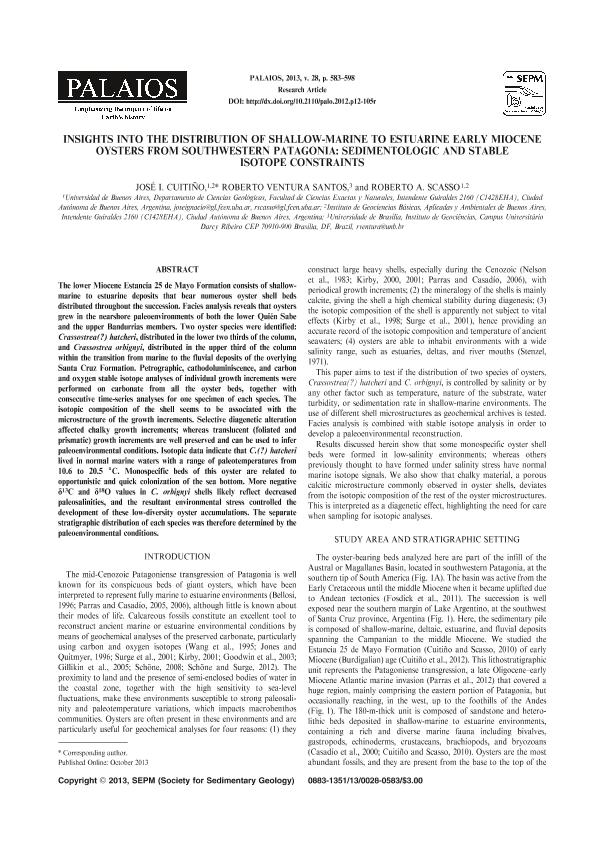Artículo
Insights into the distribution of shallow-marine to estuarine Early Miocene oysters from southwestern Patagonia: sedimentologic and stable isotope constraints
Fecha de publicación:
06/2013
Editorial:
Society For Sedimentary Geology
Revista:
Palaios
ISSN:
0883-1351
Idioma:
Inglés
Tipo de recurso:
Artículo publicado
Clasificación temática:
Resumen
The early Miocene Patagoniense transgression in southwestern Patagonia, Argentina (Estancia 25 de Mayo Formation), consists of shallow marine to estuarine deposits that bear numerous oyster shell beds distributed all over the sedimentary column. Sedimentary facies analysis reveal that oysters grew in the nearshore paleoenvironments of the stratigraphically lower Quién Sabe Member, as well as in the tide-dominated, shallow marine to estuarine paleoenvironments ofthe upper Bandurrias 26 Member. Two species lying in separate portions of the column were identified: Crassostrea? hatcheri, distributed in the lower two thirds of the column and Crassostrea orbignyi, distributed in the upper third of the column, within the transition from marine to fluvial deposits. Petrographic, cathodoluminiscence, and carbon and oxygen stable isotope analyses for individual growth increments were performed on all the oyster beds, together with serialized intra-shell analyses for one specimen of each species. The stable isotope composition of the shell was found to be strongly controlled by the microstructure due to selective diagenetic alteration of the chalky material whereas translucent (foliated and prismatic) layers are well preserved and can be used to infer paleoenvironmental conditions. Isotopic and sedimentologic data indicates that C.? hatcheri lived in shallow, normal marine waters with a range of paleotemperatures from 11º to 19ºC. Monospecific beds of this oyster are related to opportunistic and quick colonization of sea bottom. Decreasing growth rates along the ontogeny of thisoyster are registered. Highly depleted C and O isotope ratios in C. orbignyi shells resulted from paleosalinity decrease, and environmental stress controlled the development of these low-diversity oyster accumulations. The separate stratigraphic distribution of each oyster species was therefore controlled by the paleoenvironmental conditions.
Palabras clave:
Stable Isotopes
,
Paleoenvironments
,
Paleosalinity
,
Oysters
,
Shell Microstructure
Archivos asociados
Licencia
Identificadores
Colecciones
Articulos(IGEBA)
Articulos de INSTITUTO DE GEOCIENCIAS BASICAS, APLICADAS Y AMBIENTALES DE BS. AS
Articulos de INSTITUTO DE GEOCIENCIAS BASICAS, APLICADAS Y AMBIENTALES DE BS. AS
Citación
Cuitiño, José Ignacio; Santos, Roberto Ventura; Scasso, Roberto Adrian; Insights into the distribution of shallow-marine to estuarine Early Miocene oysters from southwestern Patagonia: sedimentologic and stable isotope constraints; Society For Sedimentary Geology; Palaios; 28; 6-2013; 583-598
Compartir
Altmétricas




